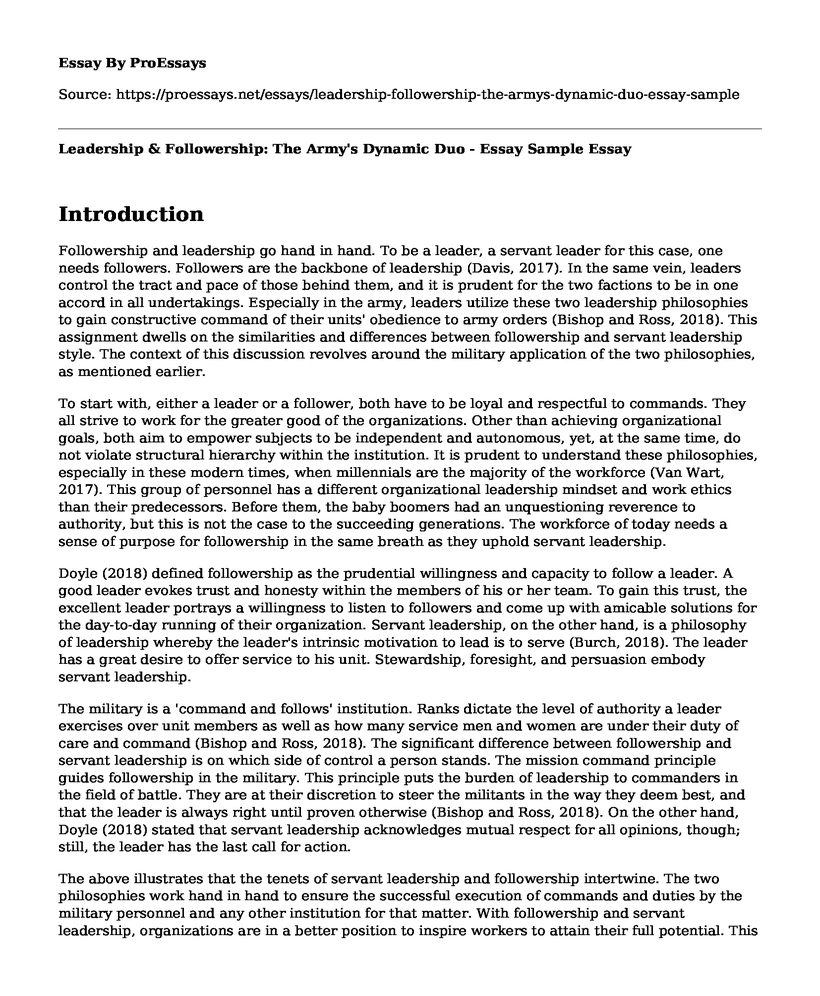Introduction
Followership and leadership go hand in hand. To be a leader, a servant leader for this case, one needs followers. Followers are the backbone of leadership (Davis, 2017). In the same vein, leaders control the tract and pace of those behind them, and it is prudent for the two factions to be in one accord in all undertakings. Especially in the army, leaders utilize these two leadership philosophies to gain constructive command of their units' obedience to army orders (Bishop and Ross, 2018). This assignment dwells on the similarities and differences between followership and servant leadership style. The context of this discussion revolves around the military application of the two philosophies, as mentioned earlier.
To start with, either a leader or a follower, both have to be loyal and respectful to commands. They all strive to work for the greater good of the organizations. Other than achieving organizational goals, both aim to empower subjects to be independent and autonomous, yet, at the same time, do not violate structural hierarchy within the institution. It is prudent to understand these philosophies, especially in these modern times, when millennials are the majority of the workforce (Van Wart, 2017). This group of personnel has a different organizational leadership mindset and work ethics than their predecessors. Before them, the baby boomers had an unquestioning reverence to authority, but this is not the case to the succeeding generations. The workforce of today needs a sense of purpose for followership in the same breath as they uphold servant leadership.
Doyle (2018) defined followership as the prudential willingness and capacity to follow a leader. A good leader evokes trust and honesty within the members of his or her team. To gain this trust, the excellent leader portrays a willingness to listen to followers and come up with amicable solutions for the day-to-day running of their organization. Servant leadership, on the other hand, is a philosophy of leadership whereby the leader's intrinsic motivation to lead is to serve (Burch, 2018). The leader has a great desire to offer service to his unit. Stewardship, foresight, and persuasion embody servant leadership.
The military is a 'command and follows' institution. Ranks dictate the level of authority a leader exercises over unit members as well as how many service men and women are under their duty of care and command (Bishop and Ross, 2018). The significant difference between followership and servant leadership is on which side of control a person stands. The mission command principle guides followership in the military. This principle puts the burden of leadership to commanders in the field of battle. They are at their discretion to steer the militants in the way they deem best, and that the leader is always right until proven otherwise (Bishop and Ross, 2018). On the other hand, Doyle (2018) stated that servant leadership acknowledges mutual respect for all opinions, though; still, the leader has the last call for action.
The above illustrates that the tenets of servant leadership and followership intertwine. The two philosophies work hand in hand to ensure the successful execution of commands and duties by the military personnel and any other institution for that matter. With followership and servant leadership, organizations are in a better position to inspire workers to attain their full potential. This a win-win situation as studies shows that satisfied and motivated employees perform best as compared to workers who feel demeaned by their superiors (Davis, 2017). The above discussion shows servant leadership and followership tag along in equal measure, and one cannot disregard the other in favor of another.
References
Bishop, R., & Ross, S. (2018). Trust and leadership in the military environment. e-Journal of Social & Behavioural Research in Business, 9(1), 76-83. http://ejsbrb.org/upload/e-JSBRB_6_Bishop_Ross_9(1)_2018.pdf
Burch, S. W. (2018). Leadership and Basic psychological needs: An exploration of how leaders can support autonomous forms of motivation through servant leadership and authentic leadership. Gonzaga University.
Davis, C. J. (Ed.). (2017). Servant leadership and followership: Examining the impact on workplace behavior. Springer.
Doyle, L. J. (2018). Come follow me! The relationship between followership, leadership, and implicit followership theories in nonprofit leaders. Trevecca Nazarene University.
Van Wart, M. (2017). Leadership in public organizations: An introduction. Taylor & Francis.
Cite this page
Leadership & Followership: The Army's Dynamic Duo - Essay Sample. (2023, May 05). Retrieved from https://proessays.net/essays/leadership-followership-the-armys-dynamic-duo-essay-sample
If you are the original author of this essay and no longer wish to have it published on the ProEssays website, please click below to request its removal:
- Essay Sample on the Cherokees Removal
- Exploring Kohl and Hofstede Values Based on the Apple Company Essay
- Catherine the Great Essay Example
- Assigment Example on Enterprise Resource Planning of Business Process Systems
- WW1: US Emerges as Superpower After Global Conflict - Essay Sample
- Essay Sample on Henry Ford: A Genius of Inclusion, Empathy, and Appreciation
- Paper Example on Employee Rights & Responsibilities: Privileges, Obligations & Ethical Treatment







